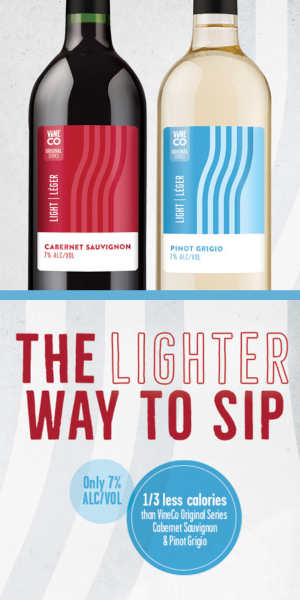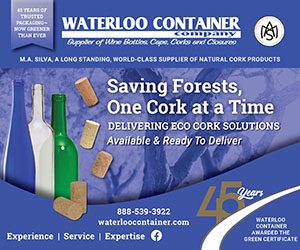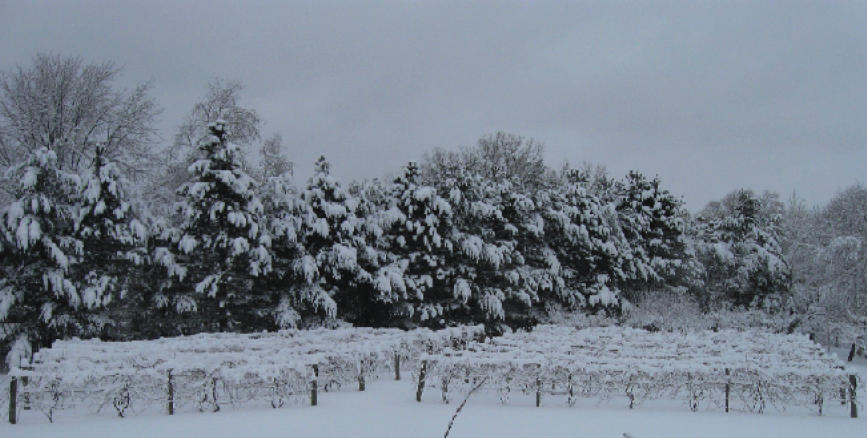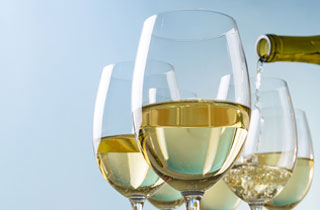
The early signs of oxidation are orange to brown colors developing in your wine. In white wine, the same exact wine (pictured above) can go from white (left) to brown (right) if oxygen exposure is not prevented.
Image by Mick Rock/Cephas Library
Based on what I have seen in wine competition results and from my judging experience, oxidation in wine remains the #1 wine fault, well ahead of other flaws
and faults encountered, and this in spite of the wide availability of information from Internet sources, magazines, and books. Statistically, white wines make
up the majority of oxidized wines given to their greater susceptibility, although oxidation is also encountered in red wines, as well as fruit and country wines. And this holds true whether the wines are made from kits, fresh juice, grapes or fresh fruits and vegetables.
Why are oxidized wines still such a common occurrence? And why are hobby winemakers not recognizing this fault and still submitting these flawed wines into competition?
Here, we review concepts in wine oxidation chemistry, how to recognize when a wine is oxidized, how to address such problems, and how to prevent them in the first place.
Understanding and Recognizing Oxidation
There are many kinds of oxidation reactions occurring during winemaking, some good and some not so good or terribly bad depending on the extent of reactions. But the flaw or fault commonly referred to as “oxidized” is the result of excessive oxygen exposure during winemaking or wine storage. The wine displays early signs of orange to brown hues and a “nutty” smell reminiscent of Sherry-like wines and progressing to a vinegary smell and taste; in the worst case, the wine takes on a pungent odor akin to nail polish remover.
Oxidation reactions can be enzymatic, chemical or microbiological in nature, and most often occur in juice and wine, but they can also occur in hanging or harvested fruit. Any fruit damaged by the elements, pests or animals, or due to improper handling during transportation, becomes a sink for yeasts, bacteria or molds to flourish. Spoilage microorganisms can penetrate damaged fruit and start their metabolic mayhem. Aerobic acetic acid bacteria are especially notorious for their capability to produce high levels of acetic acid right in the fruit.
Oxidation problems will manifest themselves in various ways but will most often result in excessive acetic acid and volatile acidity (VA), turning a good wine into an unpleasant-smelling drink and possibly undrinkable.
Rotten fruit also contains high levels of enzymes, specifically laccase enzymes, which are notorious oxidation catalysts that cause fruit and juice to turn brownish and which can persist into wine and resist sulfur dioxide (SO2). Only high SO2 doses or a thermal treatment at 113 °F (45 °C) can keep laccase in check.
In must or juice from good grapes, naturally occurring oxidative enzymes, known as polyphenoloxidase enzymes or PPOs, can also cause juice to turn brown by oxidizing phenolic acids. This happens mainly in whites as these are not shielded by protective polyphenols found in reds or other polyphenol-rich fruit, such as blueberries and pomegranate. Fortunately, PPOs are easy to control with only a small amount of sulfite and by protecting the juice from oxygen. Once fermentation has completed and the wine is sulfited, PPOs are completely inhibited and have no further effects.
Chemical oxidation, however, is more destructive in wine than in juice because oxygen is more soluble in a hydroalcoholic solution. In wine, oxidation can continue if excessive exposure to oxygen is not kept in check or if the winemaker does not sulfite the wine sufficiently. It is also catalyzed in the presence of ionized copper and iron. These metal catalysts can result, for example, from excessive use of copper in vineyard treatments or from wine processing using copper- or iron-containing equipment. Higher temperatures further catalyze oxidative reactions, hence why wine should be stored at cool temperatures, ideally around 55 °F (13 °C).
What happens during chemical oxidation is that, while polyphenols are oxidized to their brown-colored forms, oxygen is transformed into hydrogen peroxide (H2O2), a very strong oxidant — yes, this is the same hydrogen peroxide we buy from the pharmacy. H2O2 is merciless in wine: It not only binds to bisulfite ions therefore reducing SO2’s protective power, but it also oxidizes ethanol into acetaldehyde, the compound responsible for that “nutty” aroma. When acetaldehyde becomes excessive, the aroma turns to an unpleasant smell, but, more important, the compound now affects polyphenol polymerization that can affect color and mouthfeel in unpredictable ways. Acetic acid can also result from chemical (non-enzymatic) oxidation of acetaldehyde during winemaking.
Like H2O2, acetaldehyde too is a sulfite binder. And those brown-colored compounds from phenolic acid oxidation are also sulfite binders. The take-home message is that oxidation will tend to exhaust SO2 fairly rapidly, hastening oxidative effects and exposing wine to spoilage microorganisms. When SO2 becomes exhausted, acetaldehyde will bind to polyphenols and bridge anthocyanins (color pigments) and tannins to effect organoleptic changes. And remember: SO2 continues to bind to other compounds and dissipate out of bottles, albeit at a very slow rate, and so, bottled wine cannot age indefinitely and will become prone to oxidative effects over time.
Glutathione, a naturally occurring sulfur-containing tripeptide in grapes and which is released relatively abundantly into the must when grapes are crushed or pressed, is an excellent antioxidant. Additives, such as OptiWHITE containing glutathione are available to supplement juice for increased protection. But ascorbic acid should never be used during winemaking, except perhaps at bottling. The problem with ascorbic acid is that it quickly oxidizes oxygen into H2O2 — so that’s not good.
In microbiological oxidation in wine, acetic acid bacteria (most notably Acetobacter species) can metabolize ethanol into acetic acid and impart a vinegary smell and taste, and increase volatile acidity (VA). The challenge with Acetobacter is that, although being aerobic microorganisms, they can survive under anaerobic conditions and manifest their spoilage power as soon as oxygen becomes available.
And then there are surface yeasts, also known as film yeasts because of the thin film layer they produce on the surface of wine. The film is often referred to as mycoderma as Candida mycoderma was originally identified as the most common culprit yeast although other yeasts from, for example, Pichia and Metchnikowia genera, have been identified as causing similar effects in addition to producing ethyl acetate, the compound responsible for the unmistakable smell of nail polish remover. Pichia species are particularly problematic because they can produce significant amounts of acetaldehyde or ethyl acetate, and have a tendency to be tolerant to SO2.
When Oxidation is a Good Thing
Except in Sherry-style wines where oxidation is a blessing, quality falls sharply as the amount of oxygen absorbed and dissolved into white wine increases.
But in reds with a solid tannic structure, “some” level of oxygen is beneficial for enhancing structure, body and mouthfeel, and anthocyanin stability. Quality in reds is a bell-curve function of oxygen consumption — that is, quality peaks at some intermediate level of oxygen consumption depending on a wine’s polyphenol content. This is why reds are typically allowed to splash vigorously during fermentation or racking procedures, and that they benefit from the controlled oxygen in a barrel environment. Unfortunately home winemakers are not equipped to measure dissolved oxygen and oxygen consumption to be able to perform this scientifically or with any kind of accuracy; one must rely on experience with certain techniques and working with specific varieties; this is where the art of winemaking comes in.
Two specific techniques also make use of added oxygen: hyper-oxygenation (hyperox) and micro-oxygenation (mox).
Hyper-oxygenation is a white-winemaking technique where large amounts of oxygen — from air or in pure form — are injected into the must before the start of fermentation to hasten enzymatic oxidation of bitter-tasting, astringent phenolic acids into colorless compounds to minimize bitter tastes and browning effects in downstream processing and wine aging. The technique is generally recommended for neutral varieties as aromatic varieties may suffer a loss of aromas or depreciation in quality.
Micro-oxygenation is a post-fermentation red winemaking technique used to inject miniscule amounts of oxygen in controlled fashion in conjunction with oak adjuncts to bind polyphenols and allow red wine to develop its full potential of aromas and ageability. It also reduces green, herbaceous aromas much more rapidly than in conventional barrel aging in those green-prone Cabernet varieties.
Processing Impacts
The choice of processing equipment and techniques should consider the amount of oxygen uptake (in a finite amount of time) and should always be based on the variety at hand and the desired style of wine.
Oxygen uptake is greatest with increased liquid–air surface area; this means that a vigorous splash or running wine through a pump or long hoses increases the amount of oxygen absorbed by wine. A short, wide vat will cause greater oxygen uptake than a tall, narrow vat — oxygen dissolves at the liquid–air surface and works its way down. Other high-oxygen uptake operations in a home winemaking environment include crushing and pressing, pump-over, filtration and bottling.
Barrel-aging also involves copious amounts of oxygen transferred into wine; however, this occurs over very long periods of time, in the order of 12–18 months, and allows for a much more graceful polymerization of polyphenols that greatly benefits reds and select whites, such as a full-bodied Chardonnay.
And remember: Use only stainless steel or food-grade equipment and tools to process wine. Avoid anything containing copper and iron; brass (copper–zinc alloy) taps are quite popular, but they are detrimental to wine quality.
Preventing Oxidation
Before crushing or pressing, perform an extensive triage removing as much moldy fruit as possible, and lightly sulfite the harvest or juice between 25–50 mg/L depending on fruit quality. Process rosé wines as whites.
When working with white-wine varieties or fruit prone to oxidative damage, work quickly at the crusher and press, transferring the juice to carboys as quickly as possible. The juice can also be supplemented with a commercial preparation of inactivated yeast containing glutathione (GSH), such as OptiWHITE, for additional protection; OptiWHITE and OptiRED are also recommended for all types of juice and musts.
For the alcoholic fermentation, supplement yeast with nutrients at inoculation and then again at one-third Brix depletion to minimize the amount of acetaldehyde produced. Ferment at an adequate temperature for the wine at hand; this usually means fermenting whites at cool temperature while reds should not be allowed to exceed 86 °F (30 °C). Remember to not exceed the recommended range of sulfite additions as excessive SO2 will not only reversibly bind with acetaldehyde, but it will further increase its production during fermentation. The very small amount of acetaldehyde produced by yeast during fermentation is inconsequential — it actually adds to aroma complexity.
For reds, during maceration and fermentation in open vats, keep fruit flies out by placing a heavy tarp or solid lid over the vat. Fruit flies are carriers of acetic acid bacteria. They seem to come out of nowhere and quickly multiply into a little army that can pose a challenge to eradicate. A female fruit fly can lay up to 500 eggs! Don’t give them a chance. That means: Don’t leave any grape residues, fruit and vegetable waste or dirty processing equipment lying around.
Immediately sulfite wine at the end of the alcoholic fermentation (AF) or malolactic fermentation (MLF), when performed, to keep microorganisms in check. The amount added should take into account wine pH — sulfite efficacy decreases as pH increases. Use the Sulfite Calculator at www.winemakermag.com/
sulfitecalculator to guide your additions. Maintain that sulfite level throughout winemaking by making adjustments immediately after any processing activity or every three months during uninterrupted aging.
Following AF, keep carboys fully topped all the time. If you cannot top up a carboy and need to leave it partially filled for a short period of time, purge the air out by injecting an inert gas, such as argon or nitrogen, into the headspace. Although not ideal, you can repeat this every couple of weeks if you need to store the partially filled carboy for longer periods. Remember: Gas will escape the carboy even under a properly fitted solid bung. Note that complete purging may require an added gas volume that is four or five times the size of the space being filled, due to mixing during the purge.
For wines where an “oakey” character is desired but which have low polyphenol content, use oak adjuncts such as oak chips or staves — but not barrels — keeping the wine well protected from oxygen.
Top up barrels regularly when want-ing to make fuller-bodied, oak-aged wines. The topping frequency depends on the rate of wine loss, but on average, this will be once a month but it depends on the age of barrels and number of vintages used, barrel size and cellar humidity.
Dealing With Oxidation Problems
There is nothing more disconcerting than to find out that one’s wine is affected by oxidation. The success of any remedy depends on the extent of oxidation, but the wine can never be turned back into a great wine.
In the following treatments, always perform bench trials with samples to establish the efficacy of the treatment and the best rate of addition before treating the entire batch.
If the oxidized wine shows no visible sign of a browning color but smells of acetaldehyde just slightly, a sulfite addition in the range 50–100 mg/L can help bind the acetaldehyde and reduce the smell. High levels of acetaldehyde would need much higher levels of sulfite — not recommended for health reasons and the negative impacts on the wine; it is best to discard the wine.
If there is browning, check the free SO2 level and adjust accordingly based on pH, and perhaps increase the level a little; for example, if the recommended level is 35 mg/L, adjust to 50 mg/L. It is best not to try any other treatments in reds.
Slight browning in whites can be corrected using casein at a rate of 500–1000 mg/L, which works out to roughly 1⁄2 to 1 tsp. per gallon. Be careful not to overdo it as casein may strip the wine of aromas. Follow this with a bentonite treatment at a rate of 250–1000 mg/L. If your bench trials conclude that casein strips out too much aromas, try using PVPP at a rate of 250–750 mg/L. Alternatively, if you had not added any GSH-containing inactivated yeast at the crusher, perform bench trials with some OptiWHITE at the rate recommended on the package.
As an absolute last resort only and when other treatments are not effective in improving color in whites, you can try activated carbon powder at a rate of up to 50 mg/L. Never add more than the maximum because activated carbon will strip color excessively and leave a carbon-like off-flavor. Add directly to the wine and stir thoroughly. Treat the wine with bentonite immediately after the activated carbon treatment, rack after a few days, and filter before bottling.
If you detect a vinegary (acetic acid) smell in wine, there is not much that can be done to salvage the wine but to drink it if the taste is tolerable; otherwise, it is best to pour it down the drain; and no, spoiled wine does not make a good salad vinaigrette. If acetic acid is detected in wine aging in barrel, the barrel is likely laden with acetic acid bacteria and is best discarded. Trying to reuse a barrel with obvious VA is asking for trouble. And if you detect a nail polish remover (ethyl acetate) smell, discard the wine and the barrel — neither can be salvaged.
Note that if you detect a vinegary smell in wine that has gone through malolactic fermentation, the acetic acid may be the result of a citric acid addition (used to increase acidity) and not the result of oxidation. As a general rule, it is preferable to add tartaric acid to increase acidity, or only add citric acid to wine that will not undergo MLF.
If a whitish film has formed on the surface of the wine, usually the result of inadequate topping or defective equipment, you must first determine the extent of the problem. Spoilage starts at the surface and works its way down the volume of wine, and so, there is a point where there is unaffected wine. The trick then is to separate the spoiled from the good wine. Use a sanitized wine thief to retrieve a sample from just below the surface. Pour the sample in a glass, smell and taste; if the wine is off, take another sample just a little lower than previously. Repeat this process until you get a sample that smells and tastes good. Take note of the level at which you sampled good wine, then proceed to rack very carefully with as little oxygen uptake as possible and up to that level making sure to not pull any spoiled wine. Discard the spoiled wine. Immediately sulfite the wine and top up the carboy. It is also recommended to filter the wine down to a fine grade to remove as much of the latent surface yeast as possible.
After addressing any oxidation problem, review your winemaking process, the integrity of your winemaking equipment (e.g. hairline crack in a fermentation lock) and expiration dates of all additives to determine the root cause.
Prevention is Best
If you have a good knowledge of how oxidation works and follow the preventative guidelines I have outlined here for you, oxidation should never occur in your home winery. While learning to make wine, do become acquainted with how to recognize oxidation in wines (be they yours or others) so you can detect it
at home and avoid that humbling feeling and disappointment when you receive competition feedback.
Oxidation Prevention Checklist
1. Use only the best fruit. Remove any moldy or damaged grapes (or other fruit) you see when you go to press the fruit.
2. Transfer white wines quickly. Move your whites from the crusher to the press, and from vessel to vessel, as fast as you can. Consider adding an inactivated yeast containing glutathione (GSH) such as OptiWHITE for more protection.
3. Use sulfite as required based on the wine’s pH level. Use the Sulfite Calculator at www.winemaker
mag.com/sulfitecalculator to guide your additions.
4. Adjust the pH to a level less prone to oxidation. Your sulfite efficacy decreases as pH increases.
5. Discourage fruit flies. Keep all the surfaces of your winery clean and use a tarp or lid on your fermenters to keep the flies out.
6. Keep an eye on your airlocks. Make sure your airlocks do not run dry during fermentation, and make sure your stoppers are not worn out and make a proper seal.
7. Top up carboys, barrels and tanks. The risk of wine oxidizing prematurely is greatly reduced if it is not exposed to air. Prevent oxidation by eliminating head space in your vessels. If you can’t do that, purge the air regularly with an inert gas such as argon or nitrogen.
8. Use closed systems for transferring and filtering wines. Closed systems pull wine through the filters via a vacuum, thus minimizing the risk of oxidation.
9. Inspect your winemaking equipment regularly. Cracks in vessels or hoses, chips in bottles and gaps in barrel staves can all allow oxygen to reach your wine. Be dilligent in inspecting your equipment and replace things that show wear and tear.







